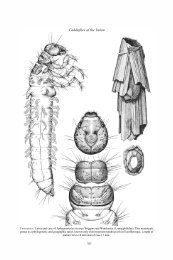No. 9 1998 ARC TIC IN SECT NEWS - Department of Biological ...
No. 9 1998 ARC TIC IN SECT NEWS - Department of Biological ...
No. 9 1998 ARC TIC IN SECT NEWS - Department of Biological ...
You also want an ePaper? Increase the reach of your titles
YUMPU automatically turns print PDFs into web optimized ePapers that Google loves.
16 <strong>ARC</strong><strong>TIC</strong> <strong>IN</strong><strong>SECT</strong> <strong>NEWS</strong> <strong>No</strong>. 9, <strong>1998</strong><br />
will be done through a hole drilled in the sea ice.<br />
These reg u lar samplings will be co-ordinated<br />
with the CTD-measurements. Slightly col oured<br />
parts <strong>of</strong> the ice cores will be melted, and the wa -<br />
ter (hopefully) containing ice algae conserved.<br />
Ice algae/phytoplankton have been reg u larly<br />
sampled in the <strong>No</strong>rth Water polynya in both<br />
1997 and <strong>1998</strong>. The planned field work will in -<br />
crease the value <strong>of</strong> these already existing data,<br />
as it will be possible to say something about the<br />
inter-annual vari a tion in the spe cies as sem -<br />
blages. Furthermore, the sampling season from<br />
previous years will be ex tended. This is im por -<br />
tant in try ing to understand the dy nam ics be -<br />
tween ice al gae and phytoplankton. For in -<br />
stance, where do the species found in the spring<br />
bloom <strong>of</strong> algae in the water masses originate<br />
from? If they do originate from the ice, this<br />
would emphasise the importance <strong>of</strong> the ice al -<br />
gae in the biological pro duc tion in the area.<br />
Part <strong>of</strong> our planned field work will be bo -<br />
tanical, and carried out in co-operation with<br />
PhD. student Inger Greve Alsos at the Univer -<br />
sity <strong>of</strong> Tromsø, <strong>No</strong>rway. She is work ing with<br />
thermophilous arc tic plant spe cies, and her<br />
main field sites are on Svalbard. The most<br />
thermophilous plant species in this archipelago<br />
are ex tremely rare. Their few, small, and<br />
disjunct present-day pop u la tions may be frag -<br />
ments <strong>of</strong> more continuous pop u la tions orig i nat -<br />
ing from im mi grants to this arctic archipelago<br />
in a warmer climatic pe riod. Knowledge <strong>of</strong> the<br />
biology, his tory, and origin <strong>of</strong> the present north -<br />
ern outposts <strong>of</strong> such species is important be -<br />
cause northward expansion <strong>of</strong> southern spe cies<br />
is expected as a result <strong>of</strong> global warming. Greve<br />
Alsos stud ies the Svalbard pop u la tions and ref -<br />
erence pop u la tions from other areas (Scandina -<br />
via, Greenland, <strong>No</strong>rth ern Canada, Alaska and<br />
Siberia) <strong>of</strong> three model species (Betula nana s.<br />
lat., Vaccinium uliginosum s. lat., and Cam -<br />
panula rotundifolia s. lat.) for molecular ge -<br />
netic vari a tion (AFLPs, CAPs, RAPDs,<br />
isozymes), pop u la tion dynamics, morphology,<br />
and taxonomic re la tion ships. The data will be<br />
used to test if the pres ent Svalbard pop u la tions<br />
are frag mented relics or founded after re cent<br />
dispersal, and to ana lyse the relationships be -<br />
tween these pop u la tions and pop u la tions from<br />
possible source ar eas to es ti mate divergence<br />
times and immigration routes. The project is a<br />
co-operation between the Uni ver sities <strong>of</strong> Oslo<br />
and Tromsø, <strong>No</strong>r way, and forms part <strong>of</strong> a larger<br />
research effort to strengthen international col -<br />
laboration on arc tic biodiversity and conserva -<br />
tion. We will be collecting plant material for<br />
Inger Greve Alsos along the west coast <strong>of</strong><br />
Greenland and from Ellesmere Island (Herschel<br />
Bay and Alexandra Fiord) based on site de -<br />
scriptions given to us by her.<br />
More information on the expedition can be<br />
found on our website:<br />
http://www.sverdrup2000.org/.<br />
Questions can be addressed to the au thor at<br />
guldborg.sovik@bio.uio.no<br />
References<br />
Sverdrup, Otto. 1903. Nyt Land. Fire Aar i Arktiske<br />
Egne. Vol. I (“New Land. Four years in Arc tic<br />
Re gions”). In <strong>No</strong>r we gian. H. Aschehoug & Co,<br />
Kristiania.<br />
Map taken from “Nyt Land” (New Land) by Otto Sverdrup,<br />
1903. The expedition will overwinter approximately at<br />
‘V.kvt.98-99’, just south <strong>of</strong> Hayes Sound, where Sverdrup<br />
overwintered with the vessel ‘Fram’ the first win ter.
















